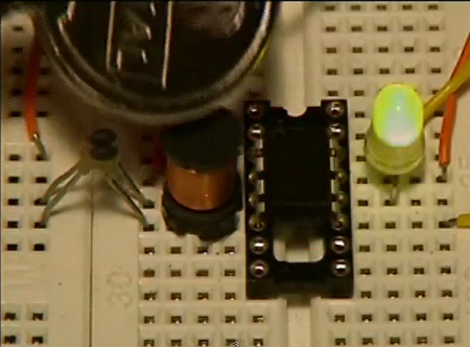
This project from a few years back is an interesting take on a metal detector. Instead of building a detection circuit, [Bruno Gavand] replaced the external clock crystal with an inductor. Here you can see the inductor coil next to the PIC 12F683. You can see two components jumping from one breadboard to the other. These are smoothing capacitors on the inductor lines.
The watchdog timer for the chip is run by the internal RC oscillator. When the external crystal receives a pulse due to metal inducing a current in the coil, the value of the watchdog timer is compared to it. This data is filtered and if the proper parameters are present the green LED blinks. This is bicolor LED. If the inductor circuit is functioning properly it will blink red at power up. [Bruno] says that results will vary based on that inductor so you may need to try a few to get the calibration light to blink.
We’re thinking this would make a simple stud finder (by detecting where the nails/screws are in the wall). Check out the demo after the break, then let us know what you would use this for by leaving a comment.
[Thanks Abend]















oh man thats old ;D
The stop lights with sensors use these too. Usually the give away is a box shape cut into the pavement. You can usually give your bike a bit of a boost with those sensors with a rare earth magnet on the bottom frame of your bike.
I think the presence of the metal changes the inductance of the coil slightly which in turn changes the frequency at which it oscillates.
It has never occured to me that you could use anything other than a crystal or a resonator for the clock of a micro, has anyone got any more info on how the oscillator in a micro works?
you could use any number of things as a clock… if you were adventurous you could use a push button, each time you push the button it would cycle the clock. really anything that toggles high low could be used. i am really drawing a blank for what you would want to do, but 555 would work, you could used dam near anything.
I wonder if you could reliably remove the PIC and use a 567 tone detector. I may have to do some playing. But I think the PIC is just over kill Could probably drop the price in half.
They are about the same price at digikey for soic-8 in single quantities… I’m sure you could skew this answer slightly if you played some games with the numbers/packages/websites…
Just saying… sometimes there isn’t a BETTER solution, just ANOTHER solution ;-) In which case, sometimes the FIRST solution is the BETTER one.
and im suddenly in the 80s O.o
a) the link is broken.
b) I think you will find that the “smoothing capacitors” are actually part of the resonant LC circuit (in LP, XT, or HS modes). See Microchip PIC12F683-E/MD datasheet and Microchip application notes AN826, AN849, AN943, AN949.
RTFM! GIYF! Get curious!
Bruno is an Ace!
Here is the link: http://www.micro-examples.com/articles/index.php/PicoDetector
He also has a wonderful PWM calculator tool that I use all the time: http://www.micro-examples.com/public/microex-navig/doc/097-pwm-calculator.html
I also made a small metal detector using a PIC but was much more complicated http://www.youtube.com/watch?v=1zyuHqi_lxY
I’ve done the AM radio/ CD case metal detector and built a BFO detector a few years back that was of poorer quality than the AM radio one lol. This looks interesting, but makes my brain curl into a question mark.
@spiralbrain thanks for the links :)
Sir can I replace the micro controller 12F683 with 12F675 same codes?
Need help.
I’m try to use this idea for build metal detector on PCB coil 60uH and 15ohm resistance.
Everything is working except when my coil is near big metal material. Then oscillator going to stop and detector is dead.
Any idea.
Good information here. I’ve tried working on a smaller version of this. It worked pretty well but it died a few days after; didn’t wanna try to look for the problem.